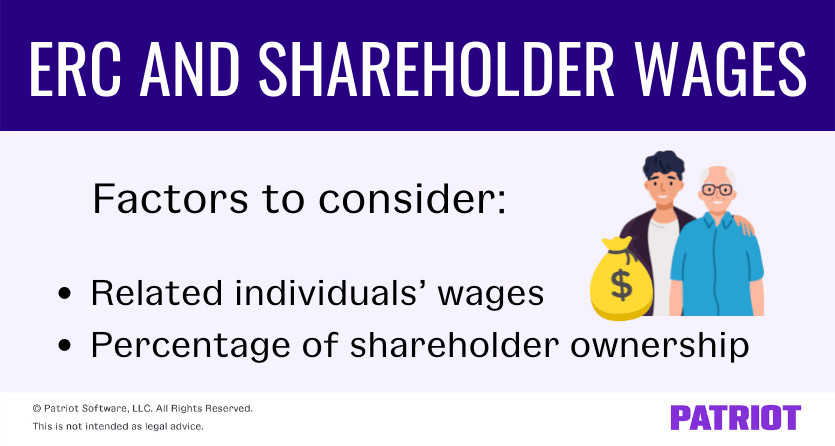Heads up: Congress recently passed the Infrastructure Investment and Jobs Act, which President Biden signed on November 15, 2021. The new expiration date of the ERTC is September 30, 2021 for most businesses.
Along with other COVID-19 relief measures, the Employee Retention Credit (ERC) took the world by storm in 2020 and 2021. Eligible employers who are able to keep employees on payroll can claim the credit (up to $28,000 per employee in 2021) through the end of 2021. But, what about shareholder wages? Are you able to claim the credit on owner wages, too? Get the scoop about Employee Retention Credit owner wages below.
Employee Retention Credit owner wages
Whether ERC owner wages count for the retention credit depends on the situation. But before we get into the nitty-gritty of owner wages and the Employee Retention Credit, let’s briefly recap shareholders and their wages.
Shareholders are considered partial owners of a company. Some shareholders may be a majority shareholder who owns more than 50% of a company’s shares of stock.
For shareholder wages Employee Retention Credit, you need to look at a couple of factors:
- Percentage of shareholder ownership
- Related individuals’ wages

Shareholder wages and Employee Retention Credit
When it comes to the ERC, the percentage of ownership matters. Why? Because wages paid to the greater-than-50% owners may not qualify for the credit. And, that’s not the only thing that matters in the IRS’s eyes. The IRS also looks at the related individuals (yes, relatives) of the majority shareholders and their wages to determine if the company can take advantage of the credit.
The IRS confirmed that wages paid to majority shareholders do not qualify for the ERC, if those shareholders have related individuals. Related individuals include the following:
- Child or a descendant of a child
- Brother, sister, stepbrother, or stepsister
- Father or mother (or an ancestor of either)
- Stepfather or stepmother
- Niece or nephew
- Aunt or uncle
- Son-in-law, daughter-in-law, father-in-law, mother-in-law, brother-in-law, or sister-in-law
If the eligible employer is a corporation, the related individual is any person who has a relationship with an individual directly or indirectly owning more than 50% in value of the corporation’s outstanding stock.
If the eligible employer is an entity other than a corporation, the related individual is a person who has a relationship with any individual directly or indirectly owning more than 50% of the capital and profits’ interests in the entity.
Sec. 267(c) defines directly and indirectly. The attribution rules of Sec. 267(c) detail entity-to-member attribution, family attribution, partner-to-partner attribution, and limits on reattribution.
Family attribution of ownership occurs between the direct owner and the owner’s brothers and sisters, spouse, ancestors, and lineal descendants. The attribution of ownership occurs regardless of whether the family member owns any portion of the business. Family attribution rules create indirect owners of a business if they are related to the direct owners. And, attribution can also cause an owner with a small portion of direct ownership to have a larger portion of direct and indirect ownership.
Wages paid to individuals that are related to a more-than-50% owner do not count as wages for the ERC. However, wages paid to an owner and the owner’s spouse count for the credit.
The bottom line: Only certain wages qualify for the Employee Retention Credit. For shareholders, it ultimately comes down to if they’re 1. A majority shareholder with more than 50% ownership and 2. If the wages were paid to a “related individual.” And, attribution of ownership can cause some wages to be disqualified from the ERC.
Want to impress your friends at a dinner party?
Get the latest payroll news delivered straight to your inbox.
Subscribe to Email ListERC shareholder wages examples
Employee Retention Credit shareholder wages can be a little complicated. To get an idea of how it all works and whether your business can take advantage of the credit, check out the examples below.
Example 1: Father and son
Let’s say a father owns 100% of a corporation and his son works for him. Because the son is a relative of the more-than-50% owner, his wages do not count for the Employee Retention Credit.
Because of family attribution, the son is also considered an indirect owner of the company. This disqualifies the father’s wages from the ERC, too.
Example 2: Mother and daughter
Pam owns 100% of ABC Corporation. She has one daughter, Meredith, who does not work for the company and has no ownership interest.
ABC Corporation pays wages to Pam. Because of attribution rules, Meredith is attributed 100% ownership of ABC, causing both Pam and Meredith to be treated as 100% owners.
Due to direct and indirect ownership, wages paid to Pam are not qualified wages for the ERC even though Meredith does not work for the corporation.
Example 3: Husband and wife
Scott owns 100% of a corporation and is married to Karen. Both of them are employees of the corporation. Neither Scott or Karen have family members that fall under the attribution rules.
Although Karen is attributed 100% ownership of the corporation due to her relationship with Scott, Scott and Karen are not considered “related individuals” by the IRS. Therefore, wages paid to Scott and Karen qualify for the ERC.
This is not intended as legal advice; for more information, please click here.



